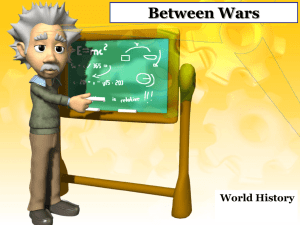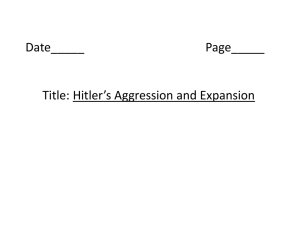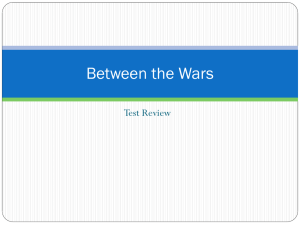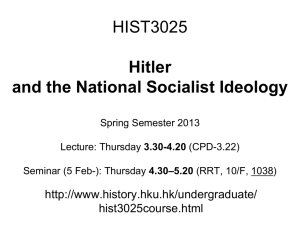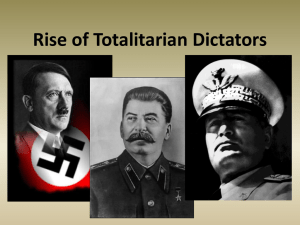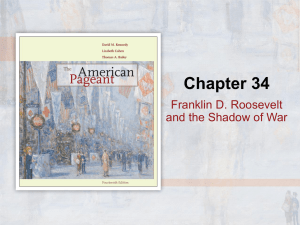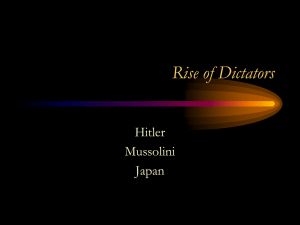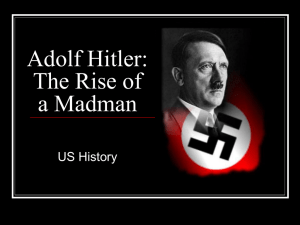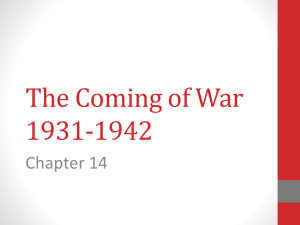World war ii* *the biggest powerpoint ever
advertisement
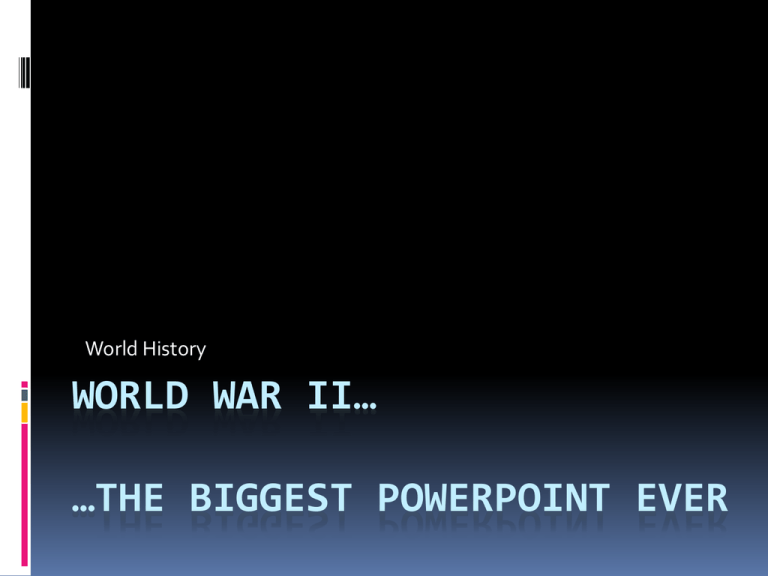
World History WORLD WAR II… …THE BIGGEST POWERPOINT EVER Fascism Rises in Europe In response to political turmoil and economic crises, Italy and Germany turn to totalitarian dictators. Fascism Rises •Fascism is a new, militant political movement • Extreme nationalism and loyalty to authoritarian leader • Italians want a leader who will take action • Fascist leader, Benito Mussolini, promises to rescue Italy • Italian king puts Mussolini in charge Fascism Rises • Adolf Hitler—obscure political figure in 1920s Germany • Nazism—German brand of fascism 1923 BEER HALL PUTSCH Hitler tries—but FAILS—to seize power from the democratically elected, but troubled, Weimar Government MEIN KAMPF (My Struggle) : written in jail, Hitler’s book outlines his plan for a Nazi Germany MEIN KAMPF 1. Superiority of German (Aryan) race; all others inferior 2. Jews were the reason for all of Germany’s problems (also Communists) 3. Treaty of Versailles must be overturned 4. Lebensraum: Germany needed “Living Space” for its people; room to EXPAND MEIN KAMPF 5. FURHER Principal: One leader should have supreme power and rule Results: Bad economic conditions get Nazi Party elected in growing #’s 1933 Ger. President appoints Hitler Chancellor Burning of Reichstag gives Nazis majority in elections Postwar Europe Unstable New Democracies German Inflation American Great Depression has worldwide impact Worldwide Unemployment (don’t write this down) Children using bundles of German marks as blocks During and after WWI, Germany just printed more money to pay for the war and reparations. This lead to severe inflation. In 1923, a loaf of bread cost 200 billion marks! Comparing Fascism to Communism COMMUNISM FASCISM Ruled by: STRICT GOV’T DICTATOR Political Parties ONE ONE Individual Rights Denied Denied Societal Classes None! (A classless society) Many •Aristocrats •Industrialist •Military •Lower middle class •Workers World View Internationalism -unite workers worldwide National issues take precedence Aggressors Invade Nations Germany, Italy, and Japan conquer other countries; the rest of the world does nothing to stop them. Aggressors March (1933-1936) Japan invades Manchuria (NE China), later takes major cities like Beijing. Chinese Nationalists and Communists fight back (remember…?) Mussolini (Italy) takes Ethiopia Hitler (Ger) takes Rhineland (border land between FR and GER) Taking Sides Britain and France follow appeasement, a policy of giving in to aggression to keep peace elsewhere Germany, Italy, and Japan—the Axis Powers— form an alliance United States follows an isolationist policy (political ties with other countries should be avoided) Axis Aggression Hitler takes Sudetenland (Czech-Ger border), and later rest of Czechoslovakia GB and FR give in; think Hitler will be satisfied • Mussolini takes Albania; Hitler demands part of Poland GB and FR continue appeasement • Nazis and Soviets secretly sign Nonaggression Pact Stalin and Hitler pledge never to attack one another War! Germany uses blitzkrieg, a new military strategy using airplanes, tanks, and MASSIVE infantry forces to SURPRISE and OVERWHELM the enemy. Takes west Poland, Denmark, Norway (http://youtu.be/n_tVtW6q9S0) Stalin expands the USSR Takes Lithuania, Latvia, Estonia, and eventually Finland France Falls May 1940, Germany moved quickly into Belgium and France Cornered Allied BR troops (had to be rescued by boat) Captured Paris by June 14 FR surrenders a week later GER controls northern FR, sets up a “puppet gov’t” in Vichy for southern FR Charles de Gaulle, FR general, leads the resistance from exile in London Battle of Britain German air force (Luftwaffe) bombarded British cities, especially London RAF (Royal Air Force) fights back They have radar and a German decoders! Germany switches to night raids Germany eventually backs out of England Considered a British victory! German Heinkel 111 bomber 23 year old RAF pilot Life in London: http://youtu.be/jvxPid5xB3Y Winston Churchill “…We shall never surrender” Other fronts… Africa Italy and BR armies compete for oil-rich land Fights go back and forth for years; GER has advantage Eastern Europe Hitler attacks and controls Balkans SURPRISE! In June 1941, Hitler invades the Soviet Union Soviet troops retreat! GER wants Leningrad and Moscow—spends 2 winters trying… Pacific Front America stays isolationist until early 1941— then sells arms to the Allies December 7, 1941—Japan attacks the American naval base at Pearl Harbor Significant damage and loss of life America declares war on Japan and its allies Japan attacks other BR and AM colonies at the same time or soon after Guam, Hong Kong, Philippines “East Asia for the Asiatics” not a term to be used now—used in the 1940’s to generally mean people from Asia Japan wants to convince the 150 million people they conquered that Asia should be ruled by other Asians, NOT COLONIALISTS Takes control of over 1 million square miles of land Often treats prisoners with extreme cruelty Japanese culture: shameful to surrender. Prisoner of War “…They took me outside and I was forced to watch as they buried six of my Scouts alive. They made the men dig their own graves, and then had them kneel down in a pit. The guards hit them over the head with shovels to stun them and piled earth on top.” Allies Fight Back by Sea Beginning: Doolittle Raid on Tokyo Not too damaging, but inspiring to Americans! Upsetting to dominant Japanese! High point: Battle of Midway AM code breakers know where Japan is headed. US Navy waits to attack at JUST the right time. It works! Savvy move: Island hopping AM and AUS forces target important islands instead of fighting for every single one Want go get closer to Japan Battle of Guadalcanal (Japan-controlled Pacific Island that AM and AUS forces attacked) “Hell was red furry spiders as big as your fist,…enormous rats and bats everywhere, and rivers with waiting crocodiles. Hell was the sour, foul smell of the squishy jungle, humidity that rotted a body within hours…Hell was an enemy…so fanatic that it used its own dead as booby traps.” Holocaust A mass genocide of races Hitler considered inferior Jews were targeted at the greatest rate (remember Mein Kampf) Roma, disabled, homosexuals, incurably ill, and others were also targeted Hitler called it the Final Solution over six million killed, most in concentration camps Turning Points North Africa Germans in control after earlier victories Allies send in two different forces (planned by Dwight D. Eisenhower) to trap the Germans GER forces in Africa defeated in May 1943 Stalingrad Major industrial city in the Caucus Mtns area of USSR Hitler wanted total control Both leaders (Hitler and Stalin) refuse to back down Enormous loss of life on both sides (over 1 million Soviets!) Begins Aug 1942, GER surrenders in Feb 1943 D-Day Invasion Allies invade at Normandy in Northern France on June 6, 1944 Largest land and sea attack in history Allies take heavy losses but push on Over one million troops land in one month By September, France, Belgium, and Luxembourg are liberated End of War in Europe Battle of the Bulge—December 1944—Germans break through weak American lines but are eventually forced to retreat April 1945—Allies invade Germany from East (Soviets) and West (AM, BR, others). Surround Berlin. April 1945—Hitler and his new wife take their own lives April and May 1945—Concentration camps are liberated (http://www.history.com/topics/world-war-ii/the-holocaust/videos/concentration-camp-liberation) May 7, 1945—General Eisenhower accepts the unconditional surrender of the Third Reich. Victory in Europe! Victory in the Pacific Guadalcanal had stopped any other Japanese advances; now retreating Battle of Leyte Gulf—October 1944—Allies take back the Philippines and destroy the Japanese naval fleet More successful (but bloody) island hopping Iwo Jima, Okinawa, others. Thousands die. Japanese Surrender Possible invasion Could cost half a million Allied lives or more Could take 1-2 years Atomic Bombs • • • • first tested July 16, 1945. Japan was warned. August 6, atomic bomb dropped on Hiroshima August 9, bomb dropped on Nagasaki Over 140,000 killed immediately, more of radiation September 2, 1945—Japan surrenders Hiroshima reading In your opinion, did the American generals and the President make the right decision? Think about those who were affected (use the reading!) and those who may have been affected if a different decision was made. Post-War Changes GOAL: Avoid future wars! Cities and farms ruined Governments struggle Nuremberg Trials—Nazi leaders were charged with crimes. Many were sentenced to prison time or death. Japan was demilitarized—disbanded the army Could fight only if attacked Japan became a constitutional monarchy Constitution written mostly by Americans

